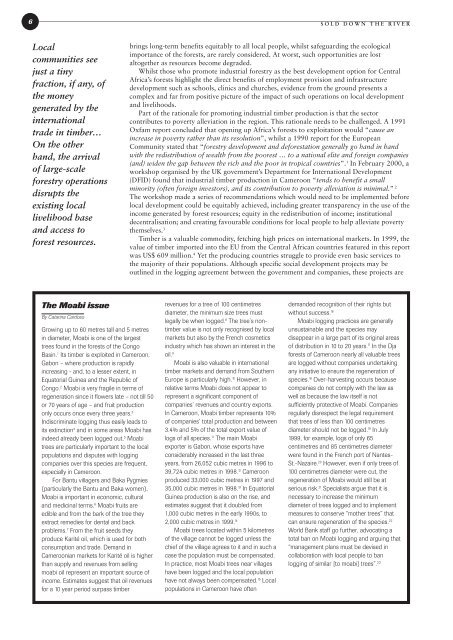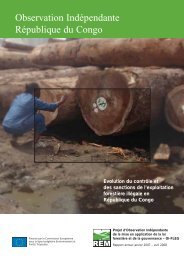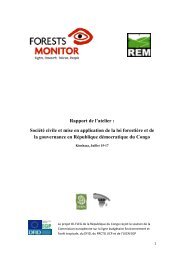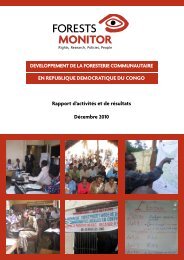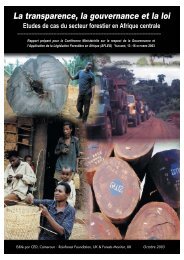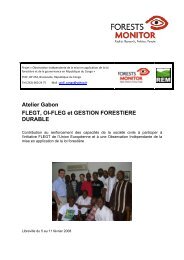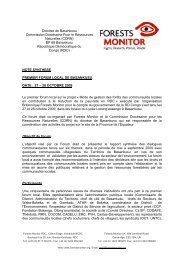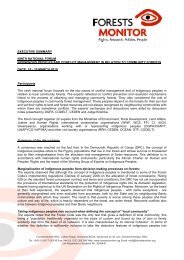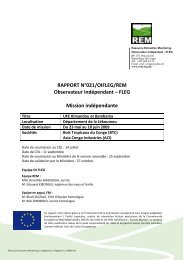6SOLD DOWN THE RIVERLocalcommunities seejust a tinyfraction, if any, of<strong>the</strong> moneygenerated by <strong>the</strong>internationaltrade in timber…On <strong>the</strong> o<strong>the</strong>rhand, <strong>the</strong> arrivalof large-sca<strong>le</strong>forestry operationsdisrupts <strong>the</strong>existing locallivelihood baseand access toforest resources.brings long-term benefits equitably to all local peop<strong>le</strong>, whilst safeguarding <strong>the</strong> ecologicalimportance of <strong>the</strong> forests, are rarely considered. At worst, such opportunities are lostaltoge<strong>the</strong>r as resources become degraded.Whilst those who promote industrial forestry as <strong>the</strong> best development option for CentralAfrica’s forests highlight <strong>the</strong> direct benefits of employment provision and infrastructuredevelopment such as schools, clinics and churches, evidence from <strong>the</strong> ground presents acomp<strong>le</strong>x and far from positive picture of <strong>the</strong> impact of such operations on local developmentand livelihoods.Part of <strong>the</strong> rationa<strong>le</strong> for promoting industrial timber production is that <strong>the</strong> sectorcontributes to poverty al<strong>le</strong>viation in <strong>the</strong> region. This rationa<strong>le</strong> needs to be chal<strong>le</strong>nged. A 1991Oxfam report concluded that opening up Africa’s forests to exploitation would “cause anincrease in poverty ra<strong>the</strong>r than its resolution”, whilst a 1990 report for <strong>the</strong> EuropeanCommunity stated that “forestry development and deforestation generally go hand in handwith <strong>the</strong> redistribution of wealth from <strong>the</strong> poorest … to a national elite and foreign companies(and) widen <strong>the</strong> gap between <strong>the</strong> rich and <strong>the</strong> poor in tropical countries”. 1 In February 2000, aworkshop organised by <strong>the</strong> UK government’s Department for International Development(DFID) found that industrial timber production in Cameroon “tends to benefit a smallminority (often foreign investors), and its contribution to poverty al<strong>le</strong>viation is minimal.” 2The workshop made a series of recommendations which would need to be imp<strong>le</strong>mented beforelocal development could be equitably achieved, including greater transparency in <strong>the</strong> use of <strong>the</strong>income generated by forest resources; equity in <strong>the</strong> redistribution of income; institutionaldecentralisation; and creating favourab<strong>le</strong> conditions for local peop<strong>le</strong> to help al<strong>le</strong>viate poverty<strong>the</strong>mselves. 3Timber is a valuab<strong>le</strong> commodity, fetching high prices on international markets. In 1999, <strong>the</strong>value of timber imported into <strong>the</strong> EU from <strong>the</strong> Central African countries featured in this reportwas US$ 609 million. 4 Yet <strong>the</strong> producing countries strugg<strong>le</strong> to provide even basic services to<strong>the</strong> majority of <strong>the</strong>ir populations. Although specific social development projects may beoutlined in <strong>the</strong> logging agreement between <strong>the</strong> government and companies, <strong>the</strong>se projects areThe Moabi issueBy Catarina CardosoGrowing up to 60 metres tall and 5 metresin diameter, Moabi is one of <strong>the</strong> largesttrees found in <strong>the</strong> forests of <strong>the</strong> CongoBasin. 1 Its timber is exploited in Cameroon,Gabon – where production is rapidlyincreasing - and, to a <strong>le</strong>sser extent, inEquatorial Guinea and <strong>the</strong> Republic ofCongo. 2 Moabi is very fragi<strong>le</strong> in terms ofregeneration since it flowers late – not till 50or 70 years of age – and fruit productiononly occurs once every three years. 3Indiscriminate logging thus easily <strong>le</strong>ads toits extinction 4 and in some areas Moabi hasindeed already been logged out. 5 Moabitrees are particularly important to <strong>the</strong> localpopulations and disputes with loggingcompanies over this species are frequent,especially in Cameroon.For Bantu villagers and Baka Pygmies(particularly <strong>the</strong> Bantu and Baka women),Moabi is important in economic, culturaland medicinal terms. 6 Moabi fruits areedib<strong>le</strong> and from <strong>the</strong> bark of <strong>the</strong> tree <strong>the</strong>yextract remedies for dental and backprob<strong>le</strong>ms. 7 From <strong>the</strong> fruit seeds <strong>the</strong>yproduce Karité oil, which is used for bothconsumption and trade. Demand inCameroonian markets for Karité oil is higherthan supply and revenues from sellingmoabi oil represent an important source ofincome. Estimates suggest that oil revenuesfor a 10 year period surpass timberrevenues for a tree of 100 centimetresdiameter, <strong>the</strong> minimum size trees must<strong>le</strong>gally be when logged. 8 The tree’s nontimbervalue is not only recognised by localmarkets but also by <strong>the</strong> French cosmeticsindustry which has shown an interest in <strong>the</strong>oil. 9 Moabi is also valuab<strong>le</strong> in internationaltimber markets and demand from Sou<strong>the</strong>rnEurope is particularly high. 10 However, inrelative terms Moabi does not appear torepresent a significant component ofcompanies’ revenues and country exports.In Cameroon, Moabi timber represents 10%of companies’ total production and between3.4% and 5% of <strong>the</strong> total export value oflogs of all species. 11 The main Moabiexporter is Gabon, whose exports haveconsiderably increased in <strong>the</strong> last threeyears, from 26,052 cubic metres in 1996 to39,724 cubic metres in 1998. 12 Cameroonproduced 33,000 cubic metres in 1997 and35,000 cubic metres in 1998. 13 In EquatorialGuinea production is also on <strong>the</strong> rise, andestimates suggest that it doub<strong>le</strong>d from1,000 cubic metres in <strong>the</strong> early 1990s, to2,000 cubic metres in 1999. 14Moabi trees located within 5 kilometresof <strong>the</strong> village cannot be logged un<strong>le</strong>ss <strong>the</strong>chief of <strong>the</strong> village agrees to it and in such acase <strong>the</strong> population must be compensated.In practice, most Moabi trees near villageshave been logged and <strong>the</strong> local populationhave not always been compensated. 15 Localpopulations in Cameroon have oftendemanded recognition of <strong>the</strong>ir rights butwithout success. 16Moabi logging practices are generallyunsustainab<strong>le</strong> and <strong>the</strong> species maydisappear in a large part of its original areasof distribution in 10 to 20 years. 17 In <strong>the</strong> Djaforests of Cameroon nearly all valuab<strong>le</strong> treesare logged without companies undertakingany initiative to ensure <strong>the</strong> regeneration ofspecies. 18 Over-harvesting occurs becausecompanies do not comply with <strong>the</strong> law aswell as because <strong>the</strong> law itself is notsufficiently protective of Moabi. Companiesregularly disrespect <strong>the</strong> <strong>le</strong>gal requirementthat trees of <strong>le</strong>ss than 100 centimetresdiameter should not be logged. 19 In July1999, for examp<strong>le</strong>, logs of only 65centimetres and 85 centimetres diameterwere found in <strong>the</strong> French port of Nantes-St.-Nazaire. 20 However, even if only trees of100 centimetres diameter were cut, <strong>the</strong>regeneration of Moabi would still be atserious risk. 21 Specialists argue that it isnecessary to increase <strong>the</strong> minimumdiameter of trees logged and to imp<strong>le</strong>mentmeasures to conserve “mo<strong>the</strong>r trees” thatcan ensure regeneration of <strong>the</strong> species. 22World Bank staff go fur<strong>the</strong>r, advocating atotal ban on Moabi logging and arguing that“management plans must be devised incollaboration with local peop<strong>le</strong> to banlogging of similar [to moabi] trees”. 23
REGIONAL OVERVIEW 7sometimes undertaken in lieu of tax payments or under contract to <strong>the</strong> government andthus are undertaken at <strong>the</strong> government’s, not <strong>the</strong> company’s, expense. Loggingcompanies have not always met <strong>the</strong>ir formal or informal agreements with regard tosocial provision. 5 In some instances, meanwhi<strong>le</strong>, taxes have been paid by companies forlocal infrastructure developments which have not materialised 6 or which are so poorlyequipped or staffed that <strong>the</strong>y are unab<strong>le</strong> to provide basic services (see boxes pages 19and 50).Local communities <strong>the</strong>mselves see just a tiny fraction, if any, of <strong>the</strong> money generatedby <strong>the</strong> international trade in timber. Some employment opportunities arise, but notnecessarily for peop<strong>le</strong> living locally; employment is often short-term and remuneration isgenerally low. Facilities for <strong>the</strong> workforce are often provided but <strong>the</strong> quality of provisioncan be very poor and o<strong>the</strong>r peop<strong>le</strong> have varying rights of access to <strong>the</strong>se facilities. On<strong>the</strong> o<strong>the</strong>r hand, <strong>the</strong> arrival of large-sca<strong>le</strong> forestry operations disrupts <strong>the</strong> existing locallivelihood base and access to forest resources. NTFPs become scarce, resulting in adirect loss of income for many local peop<strong>le</strong>s; women and <strong>the</strong> elderly are particularlybadly affected as <strong>the</strong>y are often <strong>the</strong> ones to col<strong>le</strong>ct and trade in NTFPs, providingvaluab<strong>le</strong> food and cash for families. The changing ro<strong>le</strong>s and relationships which developwithin and between communities generates conflict and often results in <strong>the</strong>marginalisation of certain communities, such as Pygmies, and community members,such as women and <strong>the</strong> elderly. Some of <strong>the</strong> most valuab<strong>le</strong> trees in terms of timber havebeen highly valued locally for <strong>the</strong>ir many uses. The over-exploitation of <strong>the</strong>se species canseriously disrupt local livelihoods and <strong>le</strong>ad to a net loss of cash income for many (see <strong>the</strong>Moabi and Sapelli boxes).Forestry operations act as a magnet, often attracting thousands of newcomers deepinto <strong>the</strong> rainforest. These new sett<strong>le</strong>ments are totally dependent on forestry activities;once <strong>the</strong> timber extraction finishes, <strong>the</strong> towns invariably collapse. Such boom-and-busttowns are not sustainab<strong>le</strong>: <strong>the</strong>y cause social tensions between newcomers and existingcommunities, increase pressure on natural resources including bushmeat, and facilitatealcoholism and prostitution.Pygmies are particularly affected by <strong>the</strong> presence of forestry companies, as <strong>the</strong>ybecome even more marginalised in relation to <strong>the</strong>ir farming neighbours and <strong>the</strong>newcomers to <strong>the</strong> forest. 7 In <strong>the</strong> logging camps of <strong>the</strong> sou<strong>the</strong>rn forests, especially around<strong>the</strong> borders between Central African Republic, Cameroon and Congo (Brazzavil<strong>le</strong>),Pygmies make up between 30% and 47% of <strong>the</strong> workforce. 8 Well-known for <strong>the</strong>ir skillsin <strong>the</strong> forest, <strong>the</strong>y are hired as guides to find <strong>the</strong> best trees and to hunt for bushmeat. 9But Pygmies are discriminated against in relation to o<strong>the</strong>r ethnic groups working in <strong>the</strong>camps, being given fewer amenities than <strong>the</strong> latter. In terms of health, food and spirituallife, <strong>the</strong>y also suffer. Diseases such as alcoholism, malaria, ulcers and tuberculosis, forexamp<strong>le</strong>, are widespread in <strong>the</strong> camps.With <strong>the</strong> degradation of forests, traditional ways of life are being eroded, threateningfood security and livelihoods. 10 Whilst <strong>the</strong> hunting of bushmeat has been a traditionallivelihood for forest peop<strong>le</strong>s, in particular Pygmies, <strong>the</strong> development of a large-sca<strong>le</strong>commercial trade in bushmeat is relatively recent and has been directly and indirectlyfacilitated by <strong>the</strong> development of timber production. As a result of <strong>the</strong>commercialisation of <strong>the</strong> bushmeat trade, wildlife populations are being decimated,including rare and endangered animals such as e<strong>le</strong>phants and lowland gorillas. Inresponse, partnerships are being formed between <strong>the</strong> private sector, internationa<strong>le</strong>nvironmental NGOs and government ministries to reduce <strong>the</strong> hunting of non-protectedspecies, to establish bushmeat substitution programmes, for examp<strong>le</strong> fish breeding andchicken farms, and to eliminate <strong>the</strong> hunting of protected species such as primates ande<strong>le</strong>phants.O<strong>the</strong>r chal<strong>le</strong>nges, however, remain largely unaddressed: how to ensure thatdevelopment of <strong>the</strong>se fragi<strong>le</strong> forest areas does not <strong>le</strong>ad to <strong>the</strong> deterioration of <strong>the</strong> forests<strong>the</strong>mselves; how to ensure that traditional rights of indigenous forest peop<strong>le</strong>s areupheld; how to ensure that development and/or conservation is inclusive and equitab<strong>le</strong>,and does not favour one group over ano<strong>the</strong>r; how to ensure that <strong>the</strong> benefits ofdevelopment are fairly distributed over <strong>the</strong> long-term between private companies, <strong>the</strong>state and local populations; how to protect <strong>the</strong> integrity of key areas of biological andcultural importance in an equitab<strong>le</strong> and culturally sensitive way; how to mitigate or haltcommercial forestry operations if <strong>the</strong>y generate poverty, degrade <strong>the</strong> forests anddiminish local peop<strong>le</strong>s’ future rights to healthy forests. The solutions to some of <strong>the</strong>seprob<strong>le</strong>ms will require radical changes in power balances, approaches to forestmanagement and policy formation.Indigenous Uses ForThe Sapelli Tree InNor<strong>the</strong>rn CongoBy Jerome LewisFor all ethnic groups living innor<strong>the</strong>rn Congo <strong>the</strong> sapelli tree(boyo in Mbendje<strong>le</strong> and mboyo inLingala) represents an importantand highly valued resource. Itsuses fall into three categories:Food, medicine, and as aconstruction material.Large sapelli are <strong>the</strong> uniquehost of <strong>the</strong> Imbrasia (Nudaurelia)oyemensis caterpillar, a highlyregarded local delicacy. Theirimportance is shown by <strong>the</strong> periodwhen <strong>the</strong> caterpillars fall from <strong>the</strong>trees being named ‘caterpillarseason’ and studies have shownthat 75% of <strong>the</strong> protein eaten byPygmies at this time is fromcaterpillars. 1 Caterpillars fall fromlarge emergent trees during <strong>the</strong>rainy season when game is difficultto hunt, fishing is unsuccessful andnext season’s crops are not yetripe. Both farmers and hunterga<strong>the</strong>rersconsider <strong>the</strong> caterpillarsa b<strong>le</strong>ssing.Sapelli caterpillars areespecially valued for <strong>the</strong>ir delicioustaste and great numbers col<strong>le</strong>ctedin a short time. Their small size(c.60mm by 15mm) and firmtexture allow <strong>the</strong>m to dry outexceptionally well for preservation.Sapelli caterpillars are a high valuetrade item in local commerce.Col<strong>le</strong>cting caterpillars is acommunal task providing animportant source of income forwomen and <strong>the</strong> elderly.The most important medicinalproperties of sapelli are <strong>the</strong>analgesic and anti-inflammatoryeffects of <strong>the</strong> bark and outer trunk.It may also have certain antibacterialproperties. 2 It iscommonly used for <strong>the</strong> treatmentof <strong>the</strong> severe head-achesassociated with malaria, of swol<strong>le</strong>nand painful eye infections and alsoto relieve exhausted and painfulfeet.The qualities of durability,strength, buoyancy and waterresistanceresult in sapelli woodbeing considered <strong>the</strong> best formaking pirogues. Sapelli is alsodesired for <strong>the</strong> central roofsupportsof local houses.


